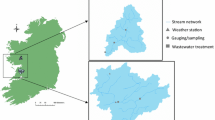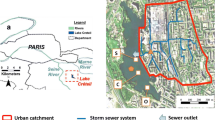Abstract
Faecal-derived microbial pollution of fresh surface waters is a global problem. Water quality models can play an important role in the management of microbial pollution; however, most existing models are too complex and require a large amount of observed data for calibration, thereby excluding their use in data-scarce catchments. The Water Quality Systems Assessment Model (WQSAM) is a water quality water model structured on the concept of requisite simplicity, thereby limiting the complexity and data requirements of the model. Here, microbial water quality simulation functionality was added to WQSAM, with the aim of assessing whether a simplified representation of processes affecting microbial water quality is sufficiently accurate for purposes of water resource management. Simulations of microbial water quality were based on the inputs and fate of an indicator organism, Escherichia coli. Non-point source inputs were modelled by assigning microbial water quality ‘signatures’ to incremental flow components, whereas a similar signature was assigned to point source inputs. The instream fate of E. coli was based on a first-order rate equation, moderated by salinity and water temperature. The model was validated by application to the upper to middle Crocodile River Catchment, Mpumalanga, South Africa, for historical conditions. Model simulations were obtained that were representative of the variability of observed temperature, salinity and microbial water quality data. The simulations of E. coli were found to be most sensitive to the decay rate k 0. It is argued here that the uncertainty in model results due to the use of a relatively simple model structure would be no more, or even less that that due to the application of a complex model to a catchment with insufficient observed data for adequate model calibration.


Similar content being viewed by others
References
Abu-Ashour J, Joy D, Lee H, Whiteley H, Zelin S (1994) Transport of microorganisms through soil. Water Air Soil Pollut 75:141–152
Basson MS, Allen RB, Pegram GGS, van Rooyen JA (1994) Probabilistic Management of Water Resource and Hydropower Systems. Water Resources Publ., Colorado, USA, 424pp
Beven K (2006) A manifesto for the equifinality thesis. J Hydrol 320:18–36
Britz TJ, Sigge GO (2012) Quantitative investigation into the link between irrigation water quality and food safety: volumes 1–4.Water Research Commission report no. 1773/1/12. Water Research Commission, Pretoria, South Africa
Burton G, Gunnison D, Lanza G (1987) Survival of pathogenic bacteria in various freshwater sediments. Appl Environ Microbiol 53:633–638
Canale R, Auer M, Owens E, Heidtke T, Effler S (1993) Modelling fecal coliform bacteria II. Model development and application. Water Res 27:703–714
Chapra S (1997) Surface water-quality modelling. The McGraw-Hill Companies, Inc., New York
Cole TM, Wells SA (2008) CE-QUAL-W2: a two-dimensional, laterally averaged, hydrodynamic and water quality model, version 3.6. Department of Civil and Environmental Engineering, Portland State University, Portland, Oregon, USA
Collins R, Rutherford K (2004) Modelling bacterial water quality in streams draining pastoral land. Water Res 38:700–712
Corapcioglu MY, Haridas A (1984) Transport and fate of microorganisms in porous media: a theoretical investigation. J Hydrol 72:149–169
Deksissa T, Meirlaen J, Ashton PJ, Vanrolleghem PA (2004) Simplifying dynamic river water quality modelling: a case study of inorganic nitrogen dynamics in the Crocodile River (South Africa). Water Air Soil Pollut 155:303–320
Department of Water Affairs and Forestry (DWAF) (1996) South African water quality guidelines volume 1: domestic water use. Department of water affairs and forestry, Pretoria, South Africa
Downer CW, Ogden FL (2004) GSSHA: model to simulate diverse stream flow producing processes. J Hydrol Eng 9(3):161–174
Edberg SC, Rice EW, Karlin RJ, Allen MJ (2000) Escherichia coli: the best biological drinking water indicator for public health protection. J Appl Microbiol 88:106–116
Erpul G, Norton L, Gabriels D (2003) Sediment transport from interrill areas under wind-driven rain. J Hydrol 276(1):184–197
Fraser R, Barten P, Pinney D (1998) Predicting stream pathogen loading from livestock using a geographical information systems-based delivery model. J Environ Qual 27:935–945
Gerba CP, Bitton G (1984) Microbial pollutants: their survival and transport pattern to groundwater. In: Bitton G, Gerba CP (eds) Groundwater pollution microbiology. Wiley, New York
Hipsey MR, Antenucci JP, Brookes JD (2008) A generic, process-based model of microbial pollution in aquatic systems. Water Resour Res 44:1–26
Hughes DA (2004) Incorporating groundwater recharge and discharge functions into an existing monthly rainfall–runoff model. Hydrol Sci J 49(2):297–311
Hughes DA, Slaughter AR (2016) Disaggregating the components of a monthly water resources system model to daily values for use with a water quality model. Environ Model Softw 80:122–131
Hughes DA, Hannart P, Watkins D (2003) Continuous baseflow separation from time series of daily and monthly streamflow data. Water SA 29(1):43–48
Jamieson R, Gordon R, Sharples K, Stratton G, Madani A (2002) Movement and persistence of fecal bacteria in agricultural soils and subsurface drainage water. Can Biosyst Eng 44:6.1–6.10
Jamieson R, Gordon R, Joy D, Lee H (2004) Assessing microbial pollution of rural surface waters: a review of current watershed scale modeling approaches. Agric Water Manag 70:1–17
Kalin L, Govindaraju RS, Hantush MM (2003) Effect of geomorphologic resolution on modeling of runoff hydrograph and sedimentograph over small watersheds. J Hydrol 276(1):89–111
Kapangaziwiri E, Hughes DA, Tanner JL and Slaughter AR (2011) Resolving uncertainties in the source of low flows in South African rivers using conceptual and modelling studies. Conceptual and modelling studies of integrated groundwater, surface water and ecological systems. In: Proceedings of Symposium H01 held during IUGG 2011, July 2011, Melbourne, Australia IAHS Publ 345, 2011
Kashefipour SM, Lin B, Harris E, Falconer RA (2002) Hydroenvironmental modelling for bathing water compliance of an estuarine basin. Water Res 36(7):1854–1868
Lynch SD (2004) Development of a raster database of annual, monthly and daily rainfall for southern Africa. WRC report no. 1156/1/04, Water Research Commission, Pretoria, South Africa
Mallory SJL, van Vuuren SJ, Pashkin EA (2008) The application of the water resources modelling platform from strategic planning through to operational control. Phys Chem Earth, Parts A/B/C 33:919–925
Mancini JL (1978) Numerical estimates of coliform mortality rates under various conditions. J Water Pollut Control Fed 50(11):2477–2484
Menon P, Billen G, Servais P (2003) Mortality rates of autochthonous and fecal bacteria in natural aquatic ecosystems. Water Res 37:4151–4158
Moore J, Smyth J, Baker E, Miner J, Moffitt D (1989) Modeling bacteria movement in livestock manure systems. Trans Am Soc Agric Eng 32:1049–1053
Nash JE, Sutcliffe JV (1970) River flow forecasting through conceptual models part I – a discussion of principles. J Hydrol 10:282–290
Pollard S, du Toit D (2011) Towards adaptive integrated water resources management in southern Africa: the role of self-organisation and multi-scale feedbacks for learning and responsiveness in the Letaba and Crocodile catchments. Water Resour Manag 25(15):4019–4035
Rivers-Moore NA, Hughes DA, Mantel S, Hill TR (2008) First steps in the development of a water temperature model framework for refining the ecological Reserve in South African rivers. Water SA 34(5):585–596
Sadeghi A, Arnold J (2002) A SWAT/Microbial sub-model for predicting pathogen loadings in surface and groundwater at watershed and basin scales. In: Proceedings of the March 11–13, 2002 Conference, Total maximum daily load (TMDL) environmental regulations, fort worth, Texas pp 56–63
Servais P, Billen G, Goncalves A, Garcia-Armisen T (2007) Modelling microbial water quality in the seine river drainage network: past, present and future situations. Hydrol Earth Syst Sci 11:1581–1592
Slaughter AR, Mantel SK (2013) A simple and rapid method to relate land cover and river flow rate to river nutrient concentration. Phys Chem Earth 66:131–138
Slaughter AR and Mantel SK (2016) The validation of algal growth processes in a water quality model using remote sensing data. Proceedings of the 8th international environmental modelling and software society (iEMSs) biennial meeting, Toulouse, France 10–14 July 2016. http://scholarsarchive.byu.edu/cgi/viewcontent.cgi?article=1374&context=iemssconference
Slaughter AR, Hughes DA, Mantel SK (2012) The development of a water quality systems Assessment model (WQSAM) and its application to the Buffalo River catchment, eastern cape, South Africa. Proceedings of the 6th international environmental modelling and software society (iEMSs) biennial meeting, Leipzig, Germany 1-5 July 2012. ISBN: 978-88-9035-742-8 http://www.iemss.org/sites/iemss2012//proceedings/I2_2_0497_Slaughter_et_al.pdf
Slaughter AR, Retief DCH, Hughes DA (2015) A method to disaggregate monthly flows to daily using daily rainfall observations: model design and testing. Hydrol Sci J 4(B):153–171 http://www.tandfonline.com/doi/pdf/10.1080/02626667.2014.993987
Smakhtin VY, Masse B (2000) Continuous daily hydrograph simulation using duration curves of a precipitation index. Hydrol Process 14:1083–1100
Sokolova E, Pettersson JR, Bergstedt O, Hermansson M (2013) Hydrodynamic modelling of the microbial water quality in a drinking water source as input for risk reduction management. J Hydrol 497:15–23
South African Department of Water and Sanitation (DWS) (2015) Resource Quality Information Services. At www. dwa.gov.za/iwqs/ (last visited May 2017)
Stirzaker R, Biggs H, Roux D (2010) Requisite simplicities to help negotiate complex problems. Ambio 39:600–607
Thomann RV (1998) The future "golden age" of predictive models for surface water quality and ecosystem management. J Environ Eng 2:94–103
Tian YQ, Gong P, Radke JD, Scarborough J (2002) Spatial and temporal modelling of microbial contaminants on grazing farmlands. J Environ Qual 31:860–869
USEPA (U.S. Environmental Protection Agency) (2001) Protocol for Developing Pathogen TMDLs. EPA 841-R-00-002. Office of Water (4503F), United States Environmental Protection Agency, Washington, D.C., 132pp
Venter SN, Lötter A, Burke LM, le Roux WJ, du Preez M (2011) Management of the microbial water quality in catchments. Water Research Commission report no. 1934/1/11, Water Research Commission, Pretoria, South Africa
Walker S, Mostaghimi S, Dillaha T, Woeste F (1990) Modeling animal waste management practices: impacts on bacteria levels in runoff from agricultural lands. Trans Am Soc Agric Eng 33:807–817
Wilkinson J, Jenkins A, Wyer M, Kay D (1995) Modelling faecal coliform dynamics in streams and rivers. Water Res 29:847–855
Wilkinson J, Kay D, Wyer M, Jenkins A (2006) Processes driving the episodic flux of faecal indicator organisms in streams impacting on recreational and shellfish harvesting waters. Water Res 40:153–161
Acknowledgements
This work was supported by the South African Water Research Commission (WRC) [Project K5/2448].
Author information
Authors and Affiliations
Corresponding author
Rights and permissions
About this article
Cite this article
Slaughter, A.R. Simulating Microbial Water Quality in Data-Scarce Catchments: an Update of the WQSAM Model to Simulate the Fate of Escherichia coli . Water Resour Manage 31, 4239–4252 (2017). https://doi.org/10.1007/s11269-017-1743-1
Received:
Accepted:
Published:
Issue Date:
DOI: https://doi.org/10.1007/s11269-017-1743-1




